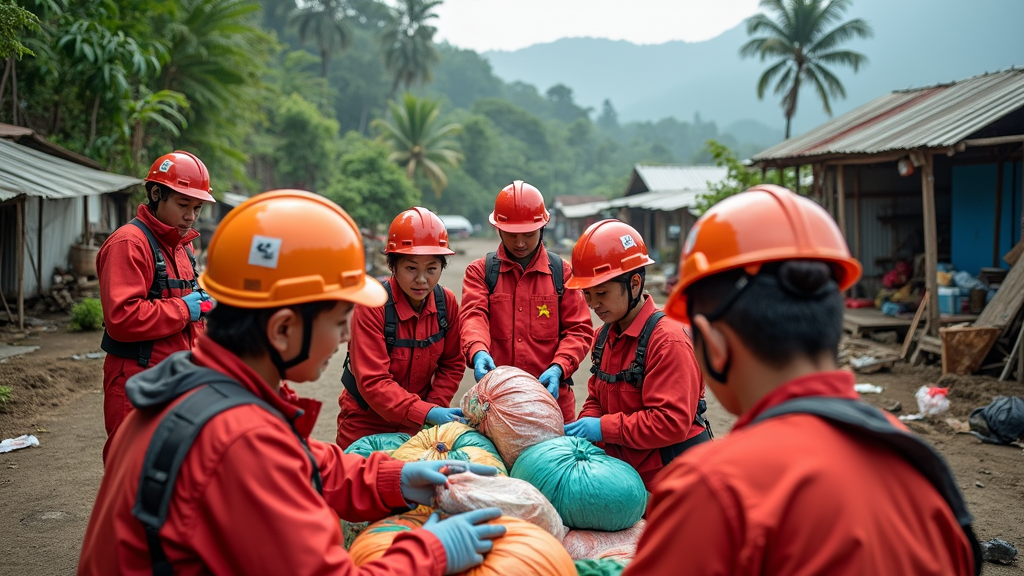China’s Fast Response Highlights US Delays in Myanmar Earthquake Aid
The Shift in Global Humanitarian Dynamics: China’s Rapid Response to the Myanmar Earthquake
The devastating earthquake that struck Myanmar has catalyzed a significant realignment in global humanitarian response dynamics. While the United States grapples with logistical realignment and restructuring efforts, China has swiftly stepped in, offering considerable financial and logistical assistance. This decisive move from China underscores a strategic shift in regional influence, highlighting the increasing complexity of international aid politics.
China’s Strategic Humanitarian Assistance
In the wake of the Myanmar earthquake, China demonstrated a swift and decisive humanitarian response, deploying assistance within 18 hours after the disaster. With a significant contribution of $14 million in aid, China’s efforts were marked by over 400 personnel actively engaging in rescue and relief operations across Thailand and Myanmar.
This rapid deployment contrasted starkly with the slower U.S. response, attributed primarily to ongoing restructuring efforts within the State Department, which affected USAID’s operational dynamics. The strategic deployment by China not only underscores its evolving role in global humanitarian efforts but also serves as a clear indication of its intent to strengthen regional alliances and influence.
U.S. Response Amid Restructuring Challenges
The U.S. response, while perceived as slower, was not absent. The State Department, amidst its restructuring to incorporate USAID roles, pledged a $2 million humanitarian aid package. However, logistics and coordination challenges have impeded a more visible presence, leaving U.S. deployed efforts reliant on existing regional partnerships.
The State Department has emphasized continued engagement and collaboration with regional partners, affirming its commitment to ongoing assistance. Yet, the restructuring process has highlighted vulnerabilities in rapid response capability and communication efficiency.
Quotations Highlighting Global Perspectives
Chinese Foreign Ministry spokesperson Mao Ning articulated China’s approach, describing their intervention as acting like “a friend in need,” further solidifying China’s narrative of reliability and readiness in crucial times.
Conversely, State Department spokesperson Tammy Bruce reiterated the U.S. presence in the region, underscoring collaboration with government partners despite challenges posed by logistical restructuring. The statement highlighted efforts to maintain engagement and operational integrity during the transitional period.
Impacts on Regional Volunteer and Multilateral Efforts
The internationally observed dynamics were further enriched by grassroots responses, as evidenced by local volunteer interactions in Thailand. Thai translator, Okt Issarkool, acknowledged learning opportunities presented by the U.S. rescue teams and their technological aid, notably drones used for assessing structural damages in affected regions.
This local acknowledgment underscores the existing reliance and expectation placed on U.S. capabilities and sophisticated technological aids in emergency relief operations, despite the slower deployment.
MapAction and Broader Humanitarian Shortcomings
Essential to understanding the broader context of the Myanmar earthquake response is the role of organizations like MapAction, which aids in United Nations efforts. Their involvement in real-time data mapping for crisis prioritization brings attention to funding challenges, with reductions directly impacting long-term planning capacity amidst an increase in climate-driven emergencies.
These funding inconsistencies, while seemingly peripheral, are crucial for understanding and addressing multifaceted humanitarian challenges, emphasizing the need for cohesive and sustainable international assistance frameworks.
Key Conclusions on Strategic and Humanitarian Implications
The current geopolitical dynamics, as showcased by China’s rapid and extensive intervention, highlight a significant shift in global humanitarian influence, underscoring China’s ascent as a key regional benefactor. This shift not only reflects strategic regional messaging but also challenges traditional perceptions of global humanitarian custodianship, traditionally led by Western powers, notably the United States.
While the structural reorganization within the U.S. presents short-term procedural challenges impacting immediate response capacity, it is anticipated that these adjustments aim towards establishing a more streamlined and effective long-term response strategy. However, these efforts continue to face scrutiny and pose critical questions about U.S. global stance and preparedness in future humanitarian crises.
The diverse organizational responses, including grassroots efforts and NGO contributions, remain integral to a holistic understanding of international humanitarian dynamics. Collectively, they offer insights into existing gaps, operational strengths, and strategic opportunities that could enhance regional and global disaster readiness.
As the world contends with increasingly complex challenges necessitating swift action, the events surrounding the Myanmar earthquake serve as a poignant reminder of the intricate balance required in global humanitarian efforts, where strategy, speed, and sustained commitment converge.
latest video
news via inbox
Subscribe to the latest news in the world of politics and technology






